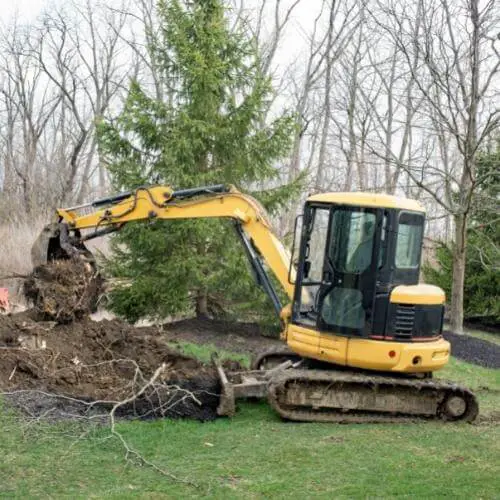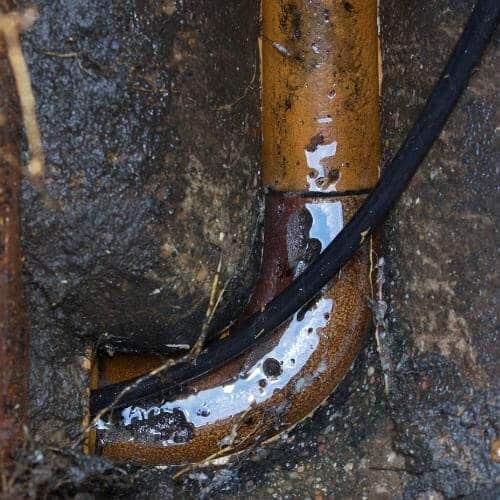The issue of tree roots growing into the ground and our pipes is a frequently possible one. Even if we take precautions the danger of this situation occurring doesn’t fully go away. However, the real question is how much do tree roots in sewer line cost to remove? Knowing the pricing and sudden jumps in cost can really help us plan ahead and prepare for the plumbing repairs that follow tree roots in sewer line cost.
How do tree roots end up in our pipes?

It’s rather simple, the tips of the tree roots can easily detect the change in moisture in the soil. This change in moisture will frequently radiate from nearby sewer pipes and thus attract tree roots towards it. The sewer pipes will eventually get reached by tree roots due to their long and expansive growing process. Once the tree root reaches the sewer pipe, it will attempt to find an entry that will allow it to get inside it. [1]
These usually end up being leaks or cracks of sewer pipes which can happen due to any number of reasons. Once the roots have gotten inside of the sewer pipe, they will not stop growing.
At first, they will cause issues with pressure and the flow of water. As time goes on, the side effects get worse until the pipe has been completely clogged. At this point, it’s also likely that our water installation will suffer a burst pipe or overflow in our yard.
Each step of these issues carries different costs but we’ll revise some of the more common resolutions and costs below as well as some overall pricing for your sewer line.
How much do tree roots in sewer line cost to remove?

As we’ve covered already, there are multiple problems caused by our tree roots when they invade our pipes. The problems will require some extensive repairs no matter the scale of the problem. After all, the roots will spread through the pipe which means we aren’t dealing with a simple localized problem.
Removing tree roots is a rather variable task when it comes to cost. The usual payment for just the removal of the tree roots starts at around $100 but can rise to be about five times more expensive. The simple fact of this problem is that it requires sewer pipes to be dug up in the first place, in order to actually start resolving the issue. For each foot of sewer pipe dug up, the cost of these fixes increases.
The sewer line cost per foot varies greatly but at the very least you’ll be paying $50 for each foot laid. The cost of sewer lines can escalate, with one of the highest price points being $250 per linear foot.
This does include the labor expenses so that’s at least one less worry. New pipes on their lonesome aren’t as pricey, costing between $3 and $20 per foot.

This isn’t even the worst situation to be in as costs can rise further if a pipe bursts. When such a situation is encountered you could be paying $3000 or higher for the replacement. It’s safe to say this isn’t the only situation where replacement is in order.
Some other situations may involve pipes that have been heavily damaged before roots even took hold, either from age or unfavorable conditions. You could end up preventing a problem early too by resolving one of the troublesome tree roots in your sewer pipe.
Another way is to consider hydro jet drain cleaning.
After all, having a burst pipe near our house could go as far as causing issues to our foundation which can be a huge expense to fix on their own.
Furthermore, our yard could end up flooding, which just makes the issue harder to contain and deal with.
Sewer line insurance
If you wish to secure yourself somewhat financially, it’s a smart move to look into sewer line insurance. This type of insurance works similarly to most other insurance policies you can purchase.
If the insured object sustains damages, you will be compensated for the costs of repairing that item. This can save quite a lot of cash at times due to the extreme costs some sewer line problems can cause.
The importance of it can be gleamed from the fact that homeowners insurance doesn’t usually cover sewer pipes.[2]
So how does it work?
Well, first it’s important to know that not everything is included in the insurance of your pipes. The coverage also depends on your source of insurance, so be careful when signing a contract.
It could end up covering little and address none of the frequent concerns that your pipes may suffer from. We’ve listed out some items that are supported by most insurance providers, we hope these will help you find the right provider for your needs.
List of supported items

Deteriorating pipes
If your pipes are old it’s all but guaranteed that they’ll eventually be damaged by deterioration. Everything has a lifespan and so do water pipes. When that lifespan nears its end, leaks and cracks become more common.
As we’ve already noted, this can escalate into other issues. Thankfully, just about any insurance provider should have you covered if deterioration does end up affecting your sewer pipes.
Excavation of pipes
If you didn’t manage to resolve the problem by other means early on, it’s almost guaranteed you’ll have to dig up the pipes. After all, they cannot be worked on if they cannot be accessed.
While you could theoretically do the job yourself and save money on constant excavations, it’s not difficult to screw up and worsen the situation when doing so. Not to mention how much time it’d take out of your day.
With insurance, this part of the job will be directly covered without any worry. You can both excavate and bury the pipes with insurance having all of it covered.
Inspection
Both you and the insurance provider benefit from occasional inspections. Inspections are a great way to find problems early as well as achieve some other benefits.
The fact that fees for these inspections will more often than not be covered by your insurance provider is just an additional reason to call somebody in to check the pipes. It could end up being more than fruitful
Pipe replacement
The key cost you may be concerned about when doing repairs on your pipes is pipe replacement and repairs. As we’ve seen, sewer pipes can be rather pricey so it’s thankful that some insurance providers will have us covered in situations where these acts are necessary to fix up the pipes.
Of course, you shouldn’t be too relaxed about these matters because more often than not insurance providers will have added stipulations that make it a bit less universal coverage. It could be tied to the price of repairs or their cause.
Sewer lines in old homes
If the house you are living in is old, then you may have some concerns to consider when it comes to sewer lines. The pipes could be made out of material that can deteriorate easily or have a slew of other issues. Let’s take a quick look into them.
Old pipe materials
These materials aren’t really optimal for sewer pipes anymore. Although they may have been the most used materials back in the day or a cheap option for those who couldn’t afford better, they have been surpassed long ago.
The first such material is lead. This used to be the most widespread material used for crafting sewer pipes before the invention of better technologies for it. The negative effects of lead, however, can be rather dangerous.
These range from simple irritation and stomach issues to memory loss. Lead pipes are also associated with physical and mental problems in children who grow up in homes with lead pipes.
Thankfully, the next type of pipe is mostly a financial loss rather than a health hazard. Galvanized pipes usually end up becoming an issue once their zinc layer erodes over time. When this happens, pipes become a lot more corrosion-prone which means leaks will start appearing quickly and frequently.
Other materials may be found as well but these two are the most common old pipe materials. If they are within your home, we suggest changing them out as soon as possible.
Pipe problems
Most of the issues with these pipes either stem from their age or poor job being done during previous installations or repairs.
Bad repairs, mediocre installation, and awkward compromises in the sewer pipe structure are guaranteed to crop up when looking over sewer pipes in old houses. We should get professionals to evaluate the issues and their costs so that we can get down to repairing them soon.
Outdated construction styles
Depending on the age of the house, we could happen upon more issues in design. These stretch far beyond materials, being outdated in their fixture and conduction design.
While this may not have an immediate effect, the outdated design will definitely prove difficult once plumbing issues start cropping up. After all, the more convoluted jobs require higher payments.
Conclusion
The best way to counteract tree roots in our sewer pipes, no matter the severity of the issue, is to be prepared. The preparation process can change depending on the home we inhabit but no matter what, knowledge is important.
The more we know beforehand about the issue the easier the resolution will be. Having information on our house’s pipes and knowing whether they are old can play quite a big role.
Knowing whether sewer pipe insurance covers the expenses of the upcoming repairs is likewise appreciated. There are many ways to resolve tree root issues. Buying commercial root killer can be rather helpful in preventing a disaster.
No matter what, information is the key part of dealing with the issue. This is why we suggest you remember the above details when tackling the prevention and resolution of tree root issues in your pipes.

Michael Davis is a heating & plumbing expert who currently works as independent contractor in SC. He also writes for Plumbertip.
For almost 10 years he worked on various plumbing tasks across South Carolina.


